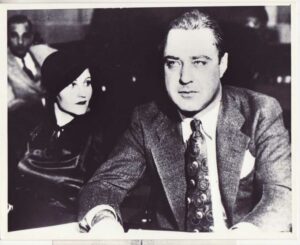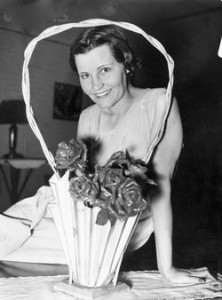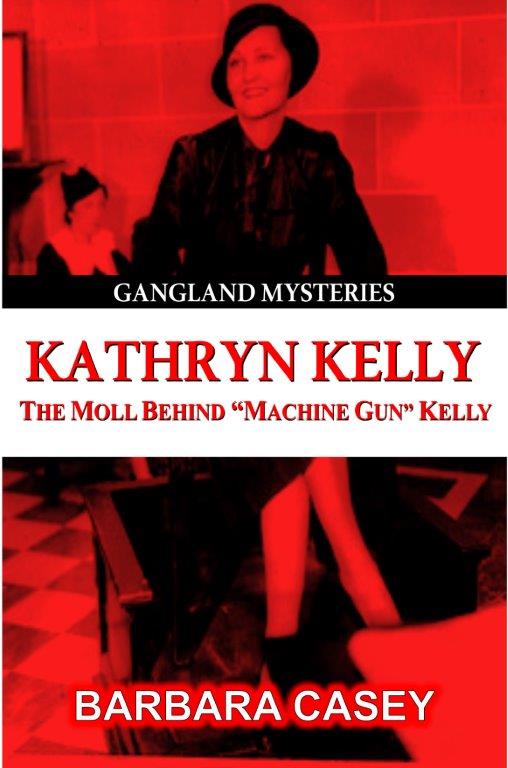*These are excerpts from the book Kathryn Kelly: The Moll behind Machine Gun Kelly by Barbara Casey.
Several years ago, thousands of our citizens shivered in fear of a kidnapper whose name had much to do with the terror he engendered: he was called Machine Gun Kelly. However, there was someone far more dangerous than Machine Gun Kelly. That was Machine Gun Kelly’s wife.
J. Edgar Hoover, 1938, Persons in Hiding
 In Oklahoma City, the case was being tried in the building that housed the post office, federal offices, and courthouse. Surrounded by armed officers, entry into the courtroom was allowed only with a pass after taking an elevator to the seventh floor and then climbing two flights of stairs to the ninth floor. In addition, everyone was required to be “patted down.” Inside, there wasn’t an empty seat available, the “electric air charged with excitement,” as it was reported on film. It was the first time movie equipment with sound had been permitted in a federal courtroom.
In Oklahoma City, the case was being tried in the building that housed the post office, federal offices, and courthouse. Surrounded by armed officers, entry into the courtroom was allowed only with a pass after taking an elevator to the seventh floor and then climbing two flights of stairs to the ninth floor. In addition, everyone was required to be “patted down.” Inside, there wasn’t an empty seat available, the “electric air charged with excitement,” as it was reported on film. It was the first time movie equipment with sound had been permitted in a federal courtroom.
There were other “firsts” as well. It was the first kidnapping trial after the passage of the “Lindbergh Law,” making kidnapping a federal crime. It was the first major case solved by J. Edgar Hoover’s evolving and powerful Federal Bureau of Investigation. It was the first crime in which defendants were transported by airplane. And, at the time, it was the largest ransom ever paid—two hundred thousand dollars, the equivalent of about three million dollars in today’s currency. The date was October 12, 1933, and George “Machine Gun” Kelly and his wife, Kathryn, were on trial for the kidnapping of wealthy Oklahoma City oil man, Charles F. Urschel.
From the old photographs and film footage that have survived, George appears uneasy and sullen, wearing a dark suit, silk tie, and white shirt; and even though smoking was forbidden in the courtroom, cameramen captured him smoking several cigarettes. The facial cuts and large bump on the side of his head that he had received from federal agent J. C. White two days earlier are also visible.
 Kathryn seems to have enjoyed the attention as she fluffs her hair and smiles confidently into the flashing and whirring cameras and posing for newsreel cameramen from Fox, Paramount, and other agencies that had followed them to Oklahoma City from Memphis where they were arrested. Fashionably dressed in high heels, a black satin dress decorated with feather epaulettes, and a hat perched jauntily on one side of her head, the members of the press and spectators alike were captivated by this tall, attractive, green-eyed brunette.
Kathryn seems to have enjoyed the attention as she fluffs her hair and smiles confidently into the flashing and whirring cameras and posing for newsreel cameramen from Fox, Paramount, and other agencies that had followed them to Oklahoma City from Memphis where they were arrested. Fashionably dressed in high heels, a black satin dress decorated with feather epaulettes, and a hat perched jauntily on one side of her head, the members of the press and spectators alike were captivated by this tall, attractive, green-eyed brunette.
Many brought their lunch so as not to lose their seats. Some members of the press noted the “Roman holiday” atmosphere. Everyone watched as Kathryn and her husband, the notorious Machine Gun Kelly, awaited their much-anticipated verdicts.
* * *
It was the era of Prohibition. Formally known as the Volstead Act and called the “greatest social experiment of modern times” by President Calvin Coolidge, it provided for easy profits to be made by the illegal sale of alcoholic beverages (defined as anything more than one-half of one percent alcohol).
It was during this period that the country was just recovering from World War I—the “War to End All Wars”—and there was created the Agricultural Adjustment Act of 1933 designed to aid farmers in difficult times with federal subsidies and low-interest loans. The Great Depression was devastating the rich and poor alike; and many across the country were waking up to find themselves in the midst of the Dust Bowl. It was a time referred to by historians and journalists as the “Dirty Thirties.”
 Images from across the country included long breadlines, make-shift relief camps, protest marches and severe dust storms sweeping over the western plains. This reality, as stark as the images, was only made worse by the stock-market crash in 1929 and the national income fell by almost half. Out of desperation, many turned to activities that were illegal in order to survive. “Public enemies“ such as John Dillinger, the Ma Barker gang, and Bonnie and Clyde, just starting to enter into the consciousness of America, were looked upon more as heroes rather than criminals as they traded gunfire with police and agents from a fledgling Federal Bureau of Investigation. It was in this environment that Ora, who worked in a grocery store, soon joined her husband in his bootlegging operations in order to make ends meet. For additional income, the couple also rented out rooms to criminals on the run for fifty dollars a night at their ranch near Paradise, Texas.
Images from across the country included long breadlines, make-shift relief camps, protest marches and severe dust storms sweeping over the western plains. This reality, as stark as the images, was only made worse by the stock-market crash in 1929 and the national income fell by almost half. Out of desperation, many turned to activities that were illegal in order to survive. “Public enemies“ such as John Dillinger, the Ma Barker gang, and Bonnie and Clyde, just starting to enter into the consciousness of America, were looked upon more as heroes rather than criminals as they traded gunfire with police and agents from a fledgling Federal Bureau of Investigation. It was in this environment that Ora, who worked in a grocery store, soon joined her husband in his bootlegging operations in order to make ends meet. For additional income, the couple also rented out rooms to criminals on the run for fifty dollars a night at their ranch near Paradise, Texas.
Wanting to leave the old, weather-beaten farmhouse for a better life, Kathryn left her daughter, Pauline, behind to be taken care of by Ora and Boss along with his five children and, at the age of twenty-nine, married a Texas bootlegger named Charlie Thorne. This was Kathryn’s third marriage, and, like her mother, she soon got involved in the bootleg business, often making the illegal deliveries.
Not long after they were married, while away visiting relatives, she learned that Charlie was cheating on her. On the way home, she stopped to get gas and told the station attendant that she was on her way to Coleman, Texas, “to kill that God-damned Charlie Thorne.” It wasn’t the first time she had threatened to kill her husband. The next day Thorne was found shot to death with Kathryn’s gun. Even though Thorne was illiterate, he had left a typed-written note that included his typed signature claiming that he “couldn’t live with or without Kathryn. Hence, I am departing this life,” the note stated.
 At first the coroner ruled that Kathryn had shot Charlie in self-defense. Later, in spite of the rumors that Kathryn had threatened to kill Charlie on numerous occasions, and a general knowledge that Charlie, who couldn’t read or write, had probably never used the word “hence” in his life, a coroner’s jury ruled that Charlie had died of a self-inflicted gunshot wound between the eyes, thereby making it a suicide. The locals believed otherwise, however, claiming that the coroner and Kathryn were “friends.”
At first the coroner ruled that Kathryn had shot Charlie in self-defense. Later, in spite of the rumors that Kathryn had threatened to kill Charlie on numerous occasions, and a general knowledge that Charlie, who couldn’t read or write, had probably never used the word “hence” in his life, a coroner’s jury ruled that Charlie had died of a self-inflicted gunshot wound between the eyes, thereby making it a suicide. The locals believed otherwise, however, claiming that the coroner and Kathryn were “friends.”
Apparently criminal behavior ran in Kathryn’s family. In addition to her mother’s bootlegging operation, she had two uncles serving time in Leavenworth, one for stealing automobiles, the other for counterfeiting. Her aunt was a prostitute and her cousin was a bootlegger. Over the next few years Kathryn was arrested several times for various crimes, including robbery in Oklahoma City where she was convicted as Mrs. J.E. Burnell. This was later reversed on appeal. She also spent time in jail for prostitution and for receiving stolen goods. It is reported that in order to avoid arrest for a robbery she was involved in, she disposed of a packet of diamonds worth over ten thousand dollars by flushing them in a hotel toilet. In Fort Worth, Kathryn was convicted of shoplifting as “Dolores Whitney,” but was released on a technicality without returning the money.
With that money and the money she had from her deceased husband, Charlie Thorne, she was able to improve her wardrobe and spend hours listening to jazz in the clubs and bars she patronized around Fort Worth. Working as a manicurist in Fort Worth at this time, Kathryn was frequently invited out on dates by local businessmen. Quite often, they would wind up on a deserted road where the businessman would be hijacked. Afterwards, by their prearranged agreement, the thief would split the money with Kathryn. One businessman in particular told a friend that the innocent little girl he was going to show a good time took him “to more speakeasies, more bootleg dives, and more holes in the wall than I thought existed in all of Texas. She knows more bums than the Police Department. She can drink liquor like water. And she’s got some of the toughest women friends I ever laid eyes on!” It was a story that J. Edgar Hoover liked to repeat years later.
With her good looks, free spirit, and taste for the “better things” in life, Kathryn never lacked for male companionship. She became involved with another bootlegger, R.L. “Little Steve” Anderson, known as “Tulsa’s leading bootlegger,” who was doing business with a dark Irish southerner who called himself George R. Kelly. There is some speculation that Kathryn was responsible for “Little Steve” hiring George, and that she had first met George at Leavenworth while he was serving time on a conviction of bootlegging and she was at the prison visiting her uncles.
 Other accounts have Kelly meeting her for the first time at a Fort Worth speakeasy where he was meeting with his new rum-running partner “Little Steve” Anderson. Kathryn was “Little Steve’s” girlfriend. Whether it was at Leavenworth or through his association with “Little Steve” that Kathryn first met George, it wasn’t long before they fell in love. Kelly used his undersized cache of bootleg and bank robbery money and oversized boasts of his business activities to dazzle Kathryn into accepting his proposal of marriage; and on September 30, 1930, after taking “Little Steve’s” Cadillac and pedigreed bulldog, they drove to Minneapolis where they were married by a Methodist minister.
Other accounts have Kelly meeting her for the first time at a Fort Worth speakeasy where he was meeting with his new rum-running partner “Little Steve” Anderson. Kathryn was “Little Steve’s” girlfriend. Whether it was at Leavenworth or through his association with “Little Steve” that Kathryn first met George, it wasn’t long before they fell in love. Kelly used his undersized cache of bootleg and bank robbery money and oversized boasts of his business activities to dazzle Kathryn into accepting his proposal of marriage; and on September 30, 1930, after taking “Little Steve’s” Cadillac and pedigreed bulldog, they drove to Minneapolis where they were married by a Methodist minister.
If you like this check out this excerpt on Crazy Charlie.



